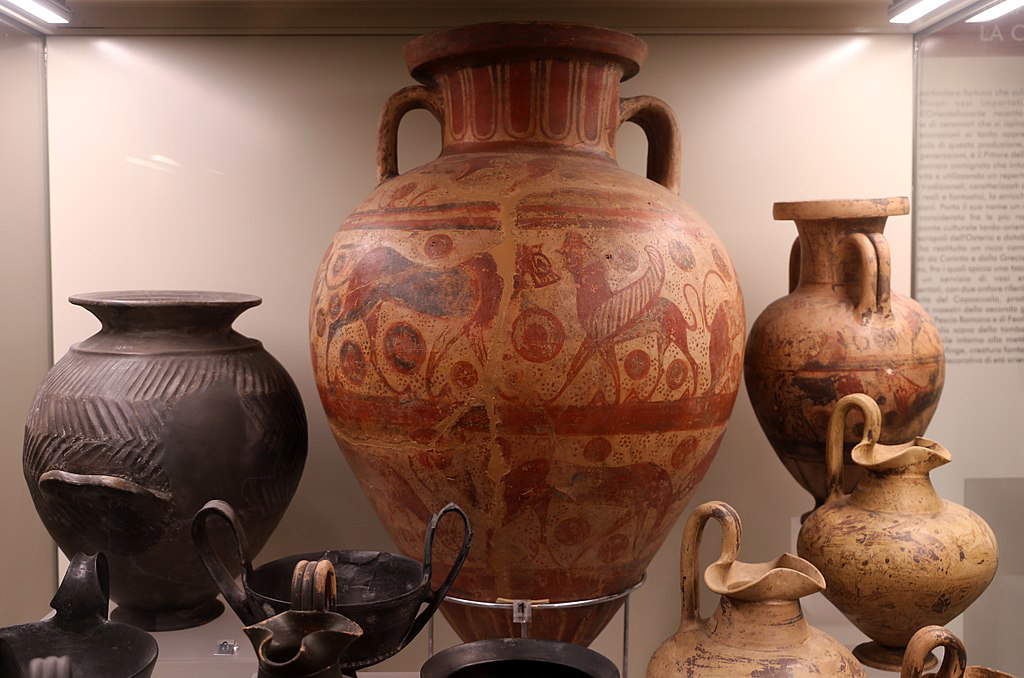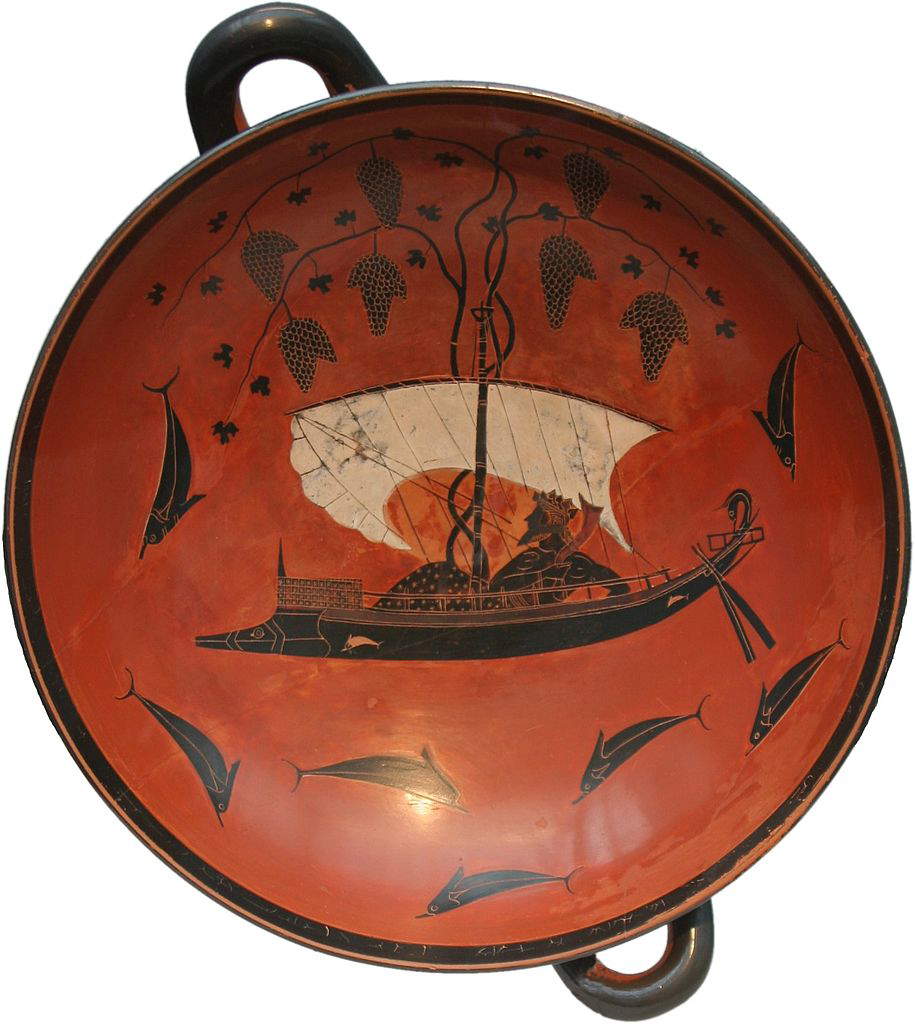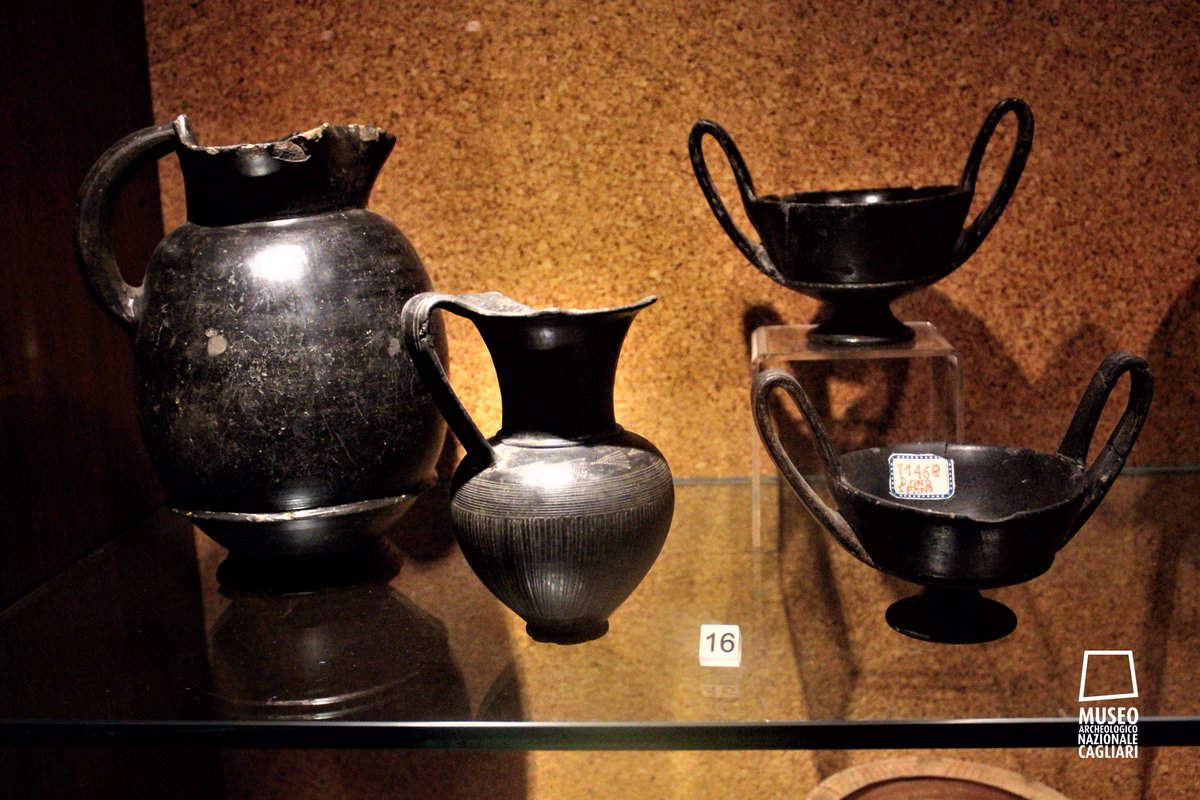If you enter an archaeological museum that has a section devoted to the Etruscans, it is almost certain that you will find large showcases filled with ceramics from every era, many produced in Etruria, but many more from Greece: they are perhaps the most vivid and eloquent evidence of Etruscan trade. In Etruria, in fact, the development of theart of pottery experienced rapid and consistent growth thanks to the relations that the Etruscans entertained with the Greeks: the presence, in southern Italy, of Greek colonies had caused several merchants to move to Italy, arriving from Greece and bringing with them Hellenic-made ceramics. At first, in the Archaic period, there was substantial trade in pottery produced in eastern Greece (e.g., Rhodes, Samos, Miletus), Corinth, or Sparta, while from the middle of the sixth century B.C.E. it would be Attic pottery that would be the most sought-after product on the market. The Etruscans became strong importers of Greek ceramics, and this allowed, as mentioned, the evolution of local schools (which, however, never reached the degree of quality of Greek models): especially in Chiusi, the production of imitation ceramics, especially red-figure ceramics, flourished. The process was also facilitated by the presence of immigrant artists from Greece, or by the skill of local artists who more than others were able to grasp the distinctive features of Greek art, thus improving the level of Etruscan ceramics. Historiography has also coined the term “Etruscan-Corinthian pottery” to designate the ceramic production that developed between the late seventh and mid-sixth centuries B.C., especially in southern Etruria (corresponding today, roughly, to the province of Viterbo), and that either drew on typical Corinthian pottery or imitated models from other Greek cities but incorporated the presence of typically Corinthian elements. One of the most active of the Etruscan-Corinthian artists was the so-called Painter of the Bearded Sphinx (so nicknamed because the figure of the bearded sphinx appears in many objects attributable to him), a prolific potter who ensured a major boost to the spread of local pottery. Patterns then changed around 550 BCE, when the import of ceramics from Corinth began to slow and the import of black-figure ceramics increased instead: workshops imitating them also sprang up in Etruria.
The importation of ceramics, although the best known and most documented, was not the only one, however: after Etruscan civilization began to become rich, prosperous, and open to the world (beginning in the seventh century B.C.), many cities in Etruria began to import goods with increasing frequency. From Greece, in addition to ceramics, they imported bronze objects (e.g., pottery and utensils for daily use), works of art (such as the so-called Pygmy of the National Archaeological Museum in Florence, an ivory work from the Hellenistic period, probably produced in Greece) and luxury goods. Trade with Gaul was also particularly active, from which slaves were imported (in Etruria, in fact, slavery was in force: there is a famous passage by Diodorus Siculus in which he tells how, on occasions of feasts and conviviality, slaves were dressed so well that they could be exchanged for their lords) and goods typical of the productions of those places, such as furs, salt and minerals such as gold and tin. From the lands of the Near East, on the other hand, pottery, ivory, and precious gold objects were imported. As for ivory, it is interesting to note that the processing of this material (secondary to, for example, that of bronze or gold) took place directly in Etruria: in fact, unprocessed ivories have been found in some archaeological excavations. In Etruria, ivory was used to make small and valuable works of art (in the article on Etruscan cosmetics the example of the Banditella comb, probably an accessory for display and not for use, was given), but also utensils and objects intended for everyday use (although these were still high-cost goods, thus the preserve of the higher social classes). Some examples are the Marsiliana tablet, a kind of “guide” to the Etruscan alphabet, but at the National Archaeological Museum in Florence or the Guarnacci Museum in Volterra there are also game dice preserved (and it is almost incredible to note how they resemble those of today), and also in Florence it is possible to find flabello handles (a particular kind of fan), clasps, scrapers.
 |
| Etruscan-Corinthian ceramics. Left: olpe (c. 580-560 B.C.; pottery; Pisa, Antiquarium of the University of Pisa). Right: two olpai and a bowl (late 7th-early 6th century B.C.; pottery; Fucecchio, Museo Civico). Ph. Credit Francesco Bini |
 |
| Center: Painter of the Bearded Sphinx, Amphora with animal figures (c. 630-580 BCE; pottery; Rome, Museo Nazionale Etrusco di Villa Giulia). Ph. Credit Francesco Bini |
 |
| Hellenistic art, Pygmy (c. 325-300 B.C.; ivory; Florence, Museo Archeologico Nazionale). Ph. Credit Francesco Bini |
 |
| Etruscan manufacture, pair of dice (7th century B.C.; ivory; Florence, Museo Archeologico Nazionale). Ph. Credit Finestre Sull’Arte |
 |
| Etruscan manufacture, flabellum handle (c. 675-625 BC; ivory; Florence, Museo Archeologico Nazionale) |
The Etruscans also had, as we would say today, a very substantial export: bucchero pottery, in particular, which was typical of Etruria and was exported to different parts of the Mediterranean and beyond, has allowed us, thanks to findings in archaeological excavations, to reconstruct with some certainty the trade routes frequented by the Etruscans. And the same applies to the wine amphorae with which the Etruscans exported another typical product of their territories, wine, which was highly prized even outside the borders of Etruria. Several interesting pieces of information have since come from the wrecks, found off the coast of Tuscany but also in other areas (for example, off the coast of Provence): we are therefore certain that there were no routes that were traveled exclusively by the Etruscans, Greeks or Carthaginians, as has long been thought. In ancient times, wrote the Etruscologist Mauro Cristofani, the Mediterranean Sea was "a remarkable mélange of men, objects and products," and the ships that plied it contained cargoes of different origins: it is therefore likely that ships collected goods produced in different locations (Etruscan amphorae have always been found alongside Greek amphorae in shipwrecks, for example) and then sorted them as needed. We do not, however, have much information about how trade was actually organized in the time he Etruscans: we can assume that, at least at first, transactions were organized in the form of exchanges (the use of money would not have begun until the first half of the fifth century B.C.), especially with regard to basic necessities. As far as luxury goods are concerned, it is likely that it was the aristocrats who provided the ships that exported Etruscan productions and returned with cargoes of goods produced outside Etruria: for such goods perhaps the Etruscans made use of the practice of gift-trade (i.e., the exchange of ceremonial gifts, which could also be bestowed in exchange for hospitality: trade practices that are difficult to understand to our eyes accustomed to monetary transactions, but these were quite normal practices in the world of the Etruscans). Greek historiography also specifies how the Etruscans were also dedicated to piracy: an author such as Ephorus of Cumae, who lived in the fourth century B.C., claimed that the Greeks feared Tyrrhenian pirates, and that this fear had hindered the Greeks from opening up trade. Sometimes the association of ideas between Etruscans and pirates to certain authors arises almost spontaneously: however, as is well known, Greek authors often proved to deal with arguments concerning the Etruscans with a certain bias.
Assessing the situation from a more impartial point of view, it should be specified that often, in antiquity, piracy and trade were overlapping activities, and it has also been assumed that, rather than pirates, the Etruscans were privateers who actually only attacked enemy ships (this was, however, a custom typical of other peoples as well, and which was also suffered by the Etruscans themselves). However, true is that the power of the Etruscans on the sea (the so-called Etruscan thalassocracy) knew considerable proportions, and for several historians of antiquity the Etruscans were, quite simply, the lords of the sea. Etruscan ships left ports located on the coastal strip stretching from Tuscany to Latium (such as Populonia in Tuscany, the only major Etruscan city bathed by the sea, or Gravisca, Pyrgi, and Regisvilla in Latium, which were the port cities on which they depended, respectively, Tarquinia, Cerveteri and Vulci) and reached the most diverse locations in the Mediterranean, traveling to Sardinia, Corsica, southern France, Spain, the territories of Carthage and Africa, Greece and Magna Graecia, and Asia Minor. The Etruscans made use of light, fast ships, equipped with an order of oars and a mast that hoisted a square sail: from depictions, especially those on pottery, we can infer that the hull was rounded, the bow sharp and the stern curved. It is then likely that the Etruscans had introduced the innovation of thelead anchor (stone anchors had been used before then). The importance that the Etruscans attached to seafaring is also evident from the works of art that have come down to us, for many navigation or fishing scenes have been preserved. It is also necessary to emphasize an important symbolic aspect related to seafaring: in fact, many Etruscan works with a marine theme include depictions of dolphins, which were considered to be an auspicious symbol (when they swam alongside ships, it was a good sign for the Etruscans) and, if painted on the walls of tombs, probably indicated that the gentleman buried there was probably in charge of some maritime enterprise.
 |
| Etruscan art, Fishing scene (530 BC; fresco; Tarquinia, Tomb of Hunting and Fishing) |
 |
| Etruscan Art, Dolphins (530 b.c.; fresco; Tarquinia, Tomb of Hunting and Fishing) |
 |
| Exekias, Kylix with myth of Dionysus and Tyrrhenian pirates transformed into dolphins (c. 530 BC; black-figure pottery, diameter 30.5 cm, height 13.6 cm; Munich, Staatliche Antikensammlungen |
 |
| Kleitias, Attic krater known as François Vase, detail showing the ship of the Athenians in Crete (c. 570 BC; black-figure pottery, 66 x 57 cm; Florence, Museo Archeologico Nazionale) |
But what were the goods that the Etruscans exported? It has already been mentioned that among the most sought-after Etruscan goods were buccheri: very simple, undecorated and similar vases have been found in different areas of the Mediterranean, suggesting a kind of standardized production, designed specifically for export to international markets, and probably also endowed with some exchange value before the introduction of money. Etruscan buccheri have been found in southern Italy, in Sicily and Sardinia, but also in other places much further afield: in southern France, in Greece, in Carthage, even in Syria. Another product in high demand, as noted above, was wine, which the Etruscans produced in quantities in excess of their needs: from the Phoenicians, the Etruscans adopted the use of amphorae for storing and transporting it, and they were adept at starting a vast production of amphorae, specifically designed for stowage in boats (these were particularly slender and easily transportable amphorae). The wide availability of iron in Etruria (especially in the mines on theisland of Elba, around which a thriving mining district sprang up) had enabled the Etruscans to export worked and tools. Bronze accessories were also in great demand:domestic bronzeutensils of Etruscan manufacture (such as vases, oil lamps, candlesticks, kitchenware) received praise even from Greek historians (such as Cirtia and Ferecrates). Other products that left Etruria for export were grain and earth products, oil, and handicrafts.
The rich trade would lead the Etruscans to expand territorially: beginning in the sixth century B.C.E., spurred also by a period of economic decline that had affected southern Etruria, we find them permanently in northern Italy, where they founded two important international emporiums, the port cities of Spina (near present-day Comacchio, and which in today’s toponymy survives in the locality of Lido di Spina) and Adria, thanks to which they were able to intensify trade with Greece, open river navigation from the Po delta to the interior, and also secure control of the Adriatic Sea. These were the ports from where the foodstuffs guaranteed by the fertile Po Valley, where there was a stable Etruscan presence in ancient times, departed mainly. Again, the Etruscans founded, in Emilia, the city of Kainua (present-day Marzabotto): this is the only Etruscan city that arose with a precise urban plan, with a regular layout, a detail that leaves little doubt about the colonial origins of this important Etruscan city in northern Italy.
 |
| Etruscan buccheri exported to Sardinia, preserved at the National Archaeological Museum in Cagliari. Ph. Credit National Archaeological Museum of Cagliari |
 |
| Etruscan manufacture, Wine amphora (late 6th to early 5th century BC; pottery; Florence, Museo Archeologico Nazionale) |
 |
| Etruscan art, Candelabra with Aeneas and Anchises, from the Valle Trebbia necropolis at Spina (c. 430-410 BC; bronze; Bologna, Museo Civico Archeologico |
Finally, it should be specified that among the Etruscans an intense trade was also alive among their cities, each of which (as indeed is the case today) specialized in the production of certain goods. For example, Chiusi was famous for its buccheri, as were Cerveteri and Bolsena, which were, however, also flourishing wine-producing centers, and again Populonia was the Etruscan capital of iron, while Tarquinia, in addition to wine and oil, traded the tuff abundant in its surroundings. Other cities such as Volterra, Veio, and Vulci were specialized centers of pottery production, Perugia and Vetulonia were important for bronze production, and Arezzo was an agricultural center where the manufacture of agricultural equipment thrived. However, even for internal trade, we have no information about how trade was organized: we do not know where the goods arrived, what the transportation systems were (we do not know, for example, whether there were important thoroughfares, nor what means of transport passed through them), what the places of exchange were, and we do not know how production was organized in the cities of origin and distribution in the cities to which the goods were destined.
A final note, finally, on money: as anticipated, it would not have begun to circulate until the fifth century B.C., and it was Populonia (given also its availability of iron) that was the first Etruscan city to mint coins. From the next century, the other city-states of Etruria would also begin to adapt.
Reference bibliography
Warning: the translation into English of the original Italian article was created using automatic tools. We undertake to review all articles, but we do not guarantee the total absence of inaccuracies in the translation due to the program. You can find the original by clicking on the ITA button. If you find any mistake,please contact us.